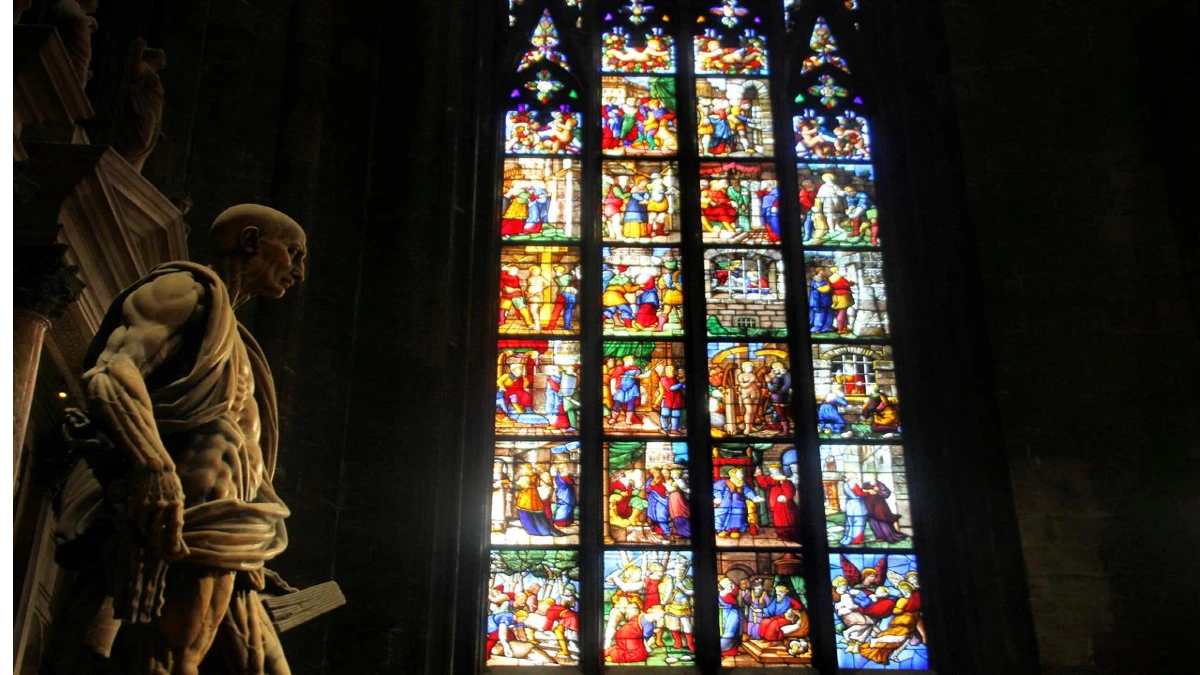
Milan Cathedral (locally known as Duomo di Milano) was under construction when the architects in charge of the project decided it was time to create a set of windows to fill the apse.
This was at the beginning of the fifteenth century.
The first pieces bear the signature of master glassmaker Michelino Da Besozzo.
At the start of the sixteenth century, the Duomo factory installed two furnaces to hasten the production of the windows that some glass masters from Flanders and Rome, including Stefano Da Pandino and Franceschino Zavattari, had designed.
The work was done quite efficiently throughout the sixteenth century.
Still, it abruptly stopped under Spanish and Austrian rule because they focused more on finishing the frescoes and statues in the cathedral chapels.
The work on the windows, created using the fire painting technique, was finished towards the end of the nineteenth century and in the early half of the twentieth century.
Milan Cathedral attracts millions of visitors each year, who come to admire its beauty, learn about its history, and take in the breathtaking views from its roof.
| Best Milan Cathedral tickets | Cost |
|---|---|
| Duomo di Milano rooftop tickets | €17 |
| Duomo di Milano, Rooftops & Museum | €20 |
| Fast Track: Duomo di Milano, Rooftops & Museum | €35 |
| Duomo di Milano & Duomo Museum | €11 |
| Guided tour: Duomo, Rooftops & Archaeological Area | €35 |
| Best of Milan tickets (Duomo, The Last Supper & Teatro alla Scala) | €99 |
Table of Contents
Religious significance of the stained glass
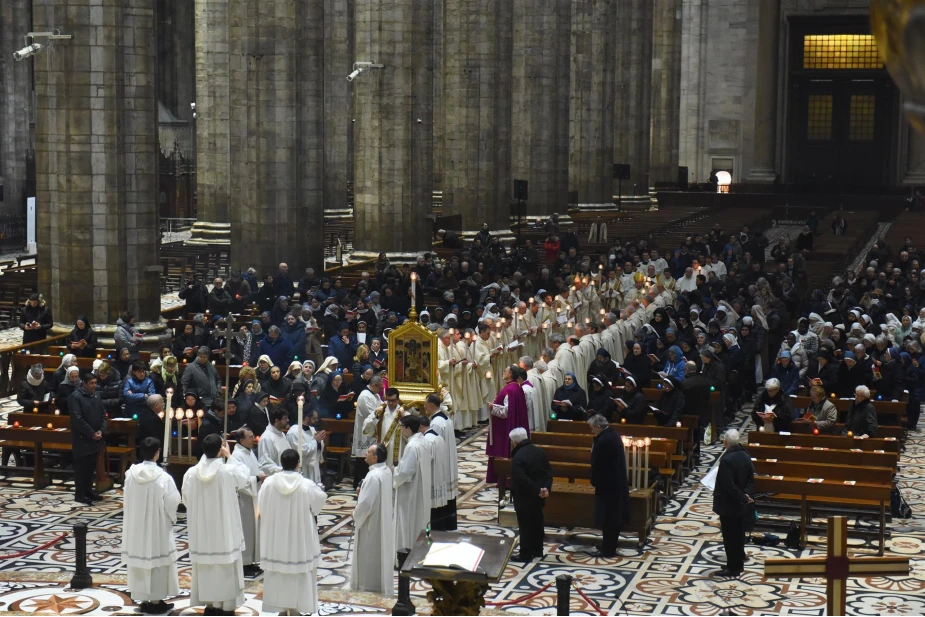
The New Testament window, created by Lombard masters who were influenced by the works of the renowned painter Foppa and the Ferrara school, is one of the most well-known and highly regarded windows.
The account of Christ’s life from the Annunciation has been well preserved and developed.
It displays the ancient artists’ use of the grisaille technique, which allowed them to transfer the design created by the painters on the boxes used as models to the glass.
The windows of San Giovanni Damasceno, commissioned by the college of apothecaries, and Sant’Eligio, the patron saint of goldsmiths, come next, followed by the window of the Apocalypse.
Giovanni Battista Bertini and his sons Pompeo and Giuseppe renovated the main apse’s Apocalypse window in the middle of the nineteenth century (1835-1839).
The upper section still contains roughly fifty pieces from the XNUMXth and XNUMXth centuries originally intended for the Vision of the Apocalypse.
Ten emblems with the Visconti coats of arms—those of Milan and two districts, Porta Orientale and Porta Vercellina—can be found beneath the rose window.
Stained glass windows of the Archangel Michael depict a tangle of angels and demons wielding pitchforks among trembling wings, heads, jerky movements, powerful strokes, punches, and bright colors to symbolize the unending conflict between good and evil.
Recommended Reading: Why you must book a guided tour of Milan Cathedral
Techniques behind Milan Cathedral’s stained glass
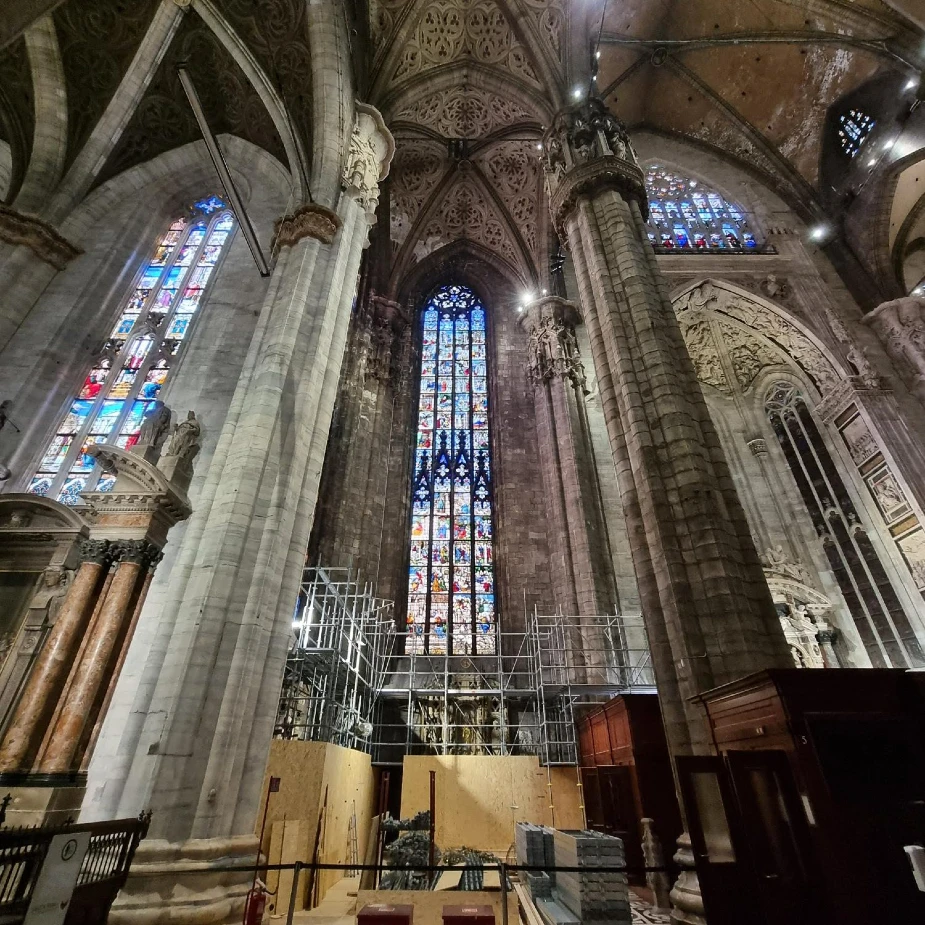
There are an astonishing fifty-five windows total, three of which are enormous towards the back.
Like other European Gothic cathedrals, the stained glass and tinted windows filter the light.
Rich stained glass windows line each side of the aisle; some are genuine, but the majority have been replaced with copies of the originals.
Each stained glass piece has a unique history connected to its period and the artist who created it.
German, French, and Italian artisans created the windows; a few names are Stephen Pandino, Nicolo Varallo, Nicholas de Bonaventuris, and Biagio Arcimboldi.
The Baptistery, the oldest section of the cathedral, is where you’ll find the bigger windows. Their design of them was made possible with the aid of Nicholas de Bonaventure.
This cathedral is designed to be where Mary worships in several ways.
The Presentation of the Madonna in the Temple by sculptor Bambaia is a lovely stained glass window inside the main entryway that shows the Virgin Mary.
The delicate image of the Virgin Mary climbing the great staircase has a strong visual impact, and she is shown as a young girl here.
The Arcimboldo family’s windows at the bottom depict Catherine of Alexandria’s tale.
The recently constructed windows of the two bishops, positioned in the middle of the aisle, have vivid colors and are very contemporary.
The first image on the left is the 1934 artwork The Tales of King David by Aldo Carpi.
Stained glass windows of the Four Crowned Saints can be seen on the bottom of the blue sky, together with architectural details typical of the Renaissance.
Milan Cathedral’s rooftop terrace is one of its most prominent features. Tourists take stairs or an elevator to the top and take in stunning views of the city.
Themes depicted in stained glass windows
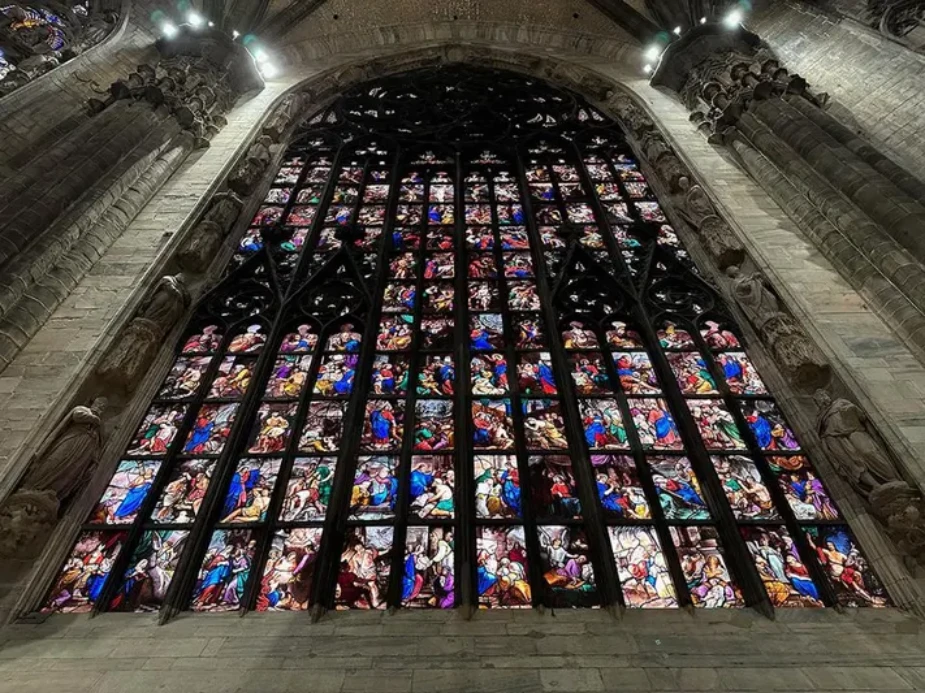
The cathedral features a vast collection of stained glass windows, many dating back to the 15th and 16th centuries. These windows depict a wide range of themes and subjects, including:
Scenes from the Bible: Many of the stained glass windows in Milan Cathedral depict scenes from the Bible, such as the story of Adam and Eve, the Nativity of Jesus, and the Crucifixion.
Saints and Martyrs: Another common theme in Milan Cathedral’s stained glass is the depiction of saints and martyrs. These figures are often shown in action, performing miracles or undergoing persecution.
Historical and Mythological Figures: Some of the stained glass windows in the cathedral also feature depictions of historical or mythological figures, such as Julius Caesar, King Solomon, or Hercules.
Natural Scenes: Some of the windows in the cathedral also feature natural scenes, such as landscapes, animals, and flowers.
Symbols and Allegories: Many stained glass windows in Milan Cathedral feature complex allegories or symbols, which can be interpreted in various ways.
The stained glass windows in Milan Cathedral are a rich and varied representation of the history, culture, and beliefs of the people who created them.
Recommended Reading: Interesting facts about Duomo Di Milano
Restoration and preservation stained glass
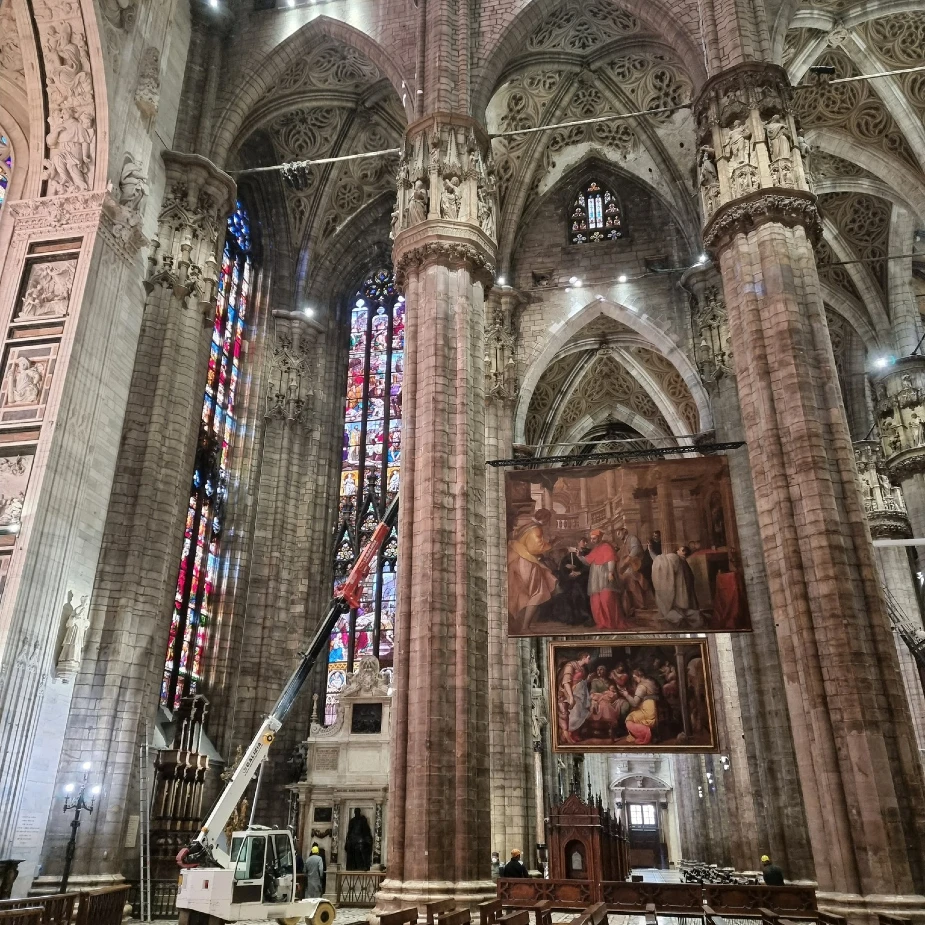
The stained glass windows for the facade were created immediately following World War II.
They were pulled down and stored in a crypt during the war to safeguard them from bombings.
The stained glass windows of Milan Cathedral are an important part of its history and beauty, and over the centuries, many efforts have been made to restore and preserve them.
Glass deteriorates as a result of both human and natural factors, including the attack of fungi, lichens, molds, and bacterial colonies, and the effects of fine dust, pollutant and aggressive gasses, acidic rainwater, and vibrations induced by traffic.
The preservation and restoration of the windows were done concurrently with the restoration of the marble on the walls where the window in question is placed for obvious reasons necessitated by the organization of the work site and safety.
After executing a sample window, the lengthy and detailed restoration work was completed in accordance with the methodology agreed upon by the two Superintendency offices of Milan and Fabbrica.
More recently, a new project was launched to restore and conserve the stained glass windows of the Cathedral.
The restoration work combined traditional and modern techniques, including using lasers to clean the glass and computer models to help recreate missing sections.
The project also involved extensive research and documentation to ensure that the original colors and designs of the windows were preserved as much as possible.
The stained glass windows of Milan Cathedral continue to be an important part of its heritage and beauty. These windows will continue to shine through ongoing restoration and preservation efforts for generations.
Milan Cathedral’s interior is massive, with soaring arches, intricate carvings, and a wealth of art and decoration.
Best tours to see the stained glass windows
Many tourists want to explore the cathedral and know everything about that place, so many guided and private tours are available for Duomo Di Milano.
| Best Milan Cathedral tickets | Cost |
|---|---|
| Duomo di Milano rooftop tickets | €17 |
| Duomo di Milano, Rooftops & Museum | €20 |
| Fast Track: Duomo di Milano, Rooftops & Museum | €35 |
| Duomo di Milano & Duomo Museum | €11 |
| Guided tour: Duomo, Rooftops & Archaeological Area | €35 |
| Best of Milan tickets (Duomo, The Last Supper & Teatro alla Scala) | €99 |
A visit to Milan Cathedral is a chance to experience the awe-inspiring beauty and history of one of the world’s most impressive Gothic cathedrals.
